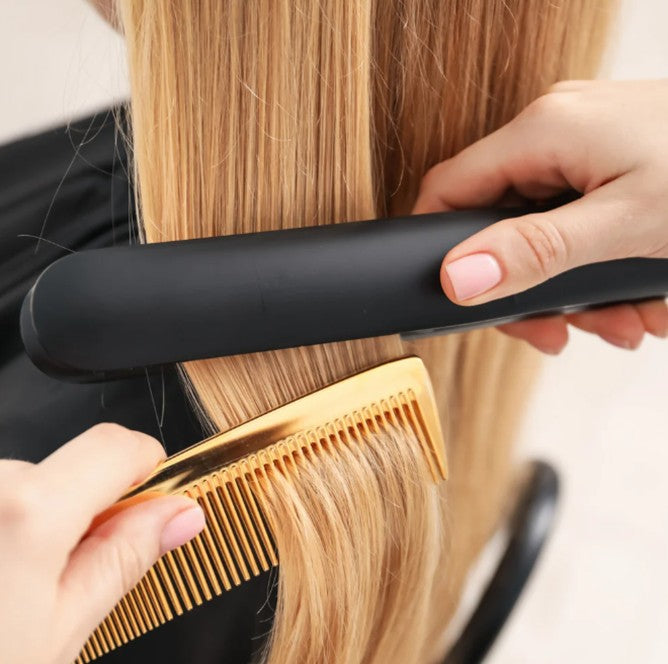How To Get Rid Of Hair Dye On Skin?
by BRENDA L. / 8 AOÛT 2022

Reading Time: 4 Minutes
Index
It’s not that we don’t support dyeing your human hair extensions at all, but we don’t recommend it for a series of reasons. However, if you’ve decided to take the job into your hands regardless unless you’re a trained professional it is likely that you have been left with a few hair dye stains on your skin (and potentially, on your clothes too). Yes, even if you followed our tutorial on how to dye your hair extensions.
Don’t panic, there are a few tricks that you can use. If you want to know everything about how to remove hair dye stains, read on and try these homemade remedies to clean your skin.
1. Baby Wipes
According to experts, baby wipes are a gentle, quick remedy for when your hair dye is running somewhere it’s not supposed to. Work with a fresh baby wipe in circular motions, to promote blood flow to the area and warm up the color, so that it can get out of your skin faster. When thinking about the product, always be mindful of your skin type and eventual allergies.

2. Petroleum Jelly
This remedy is also used as a pre-dye job by hair professionals. Ever noticed how they tend to spread it across your hairline before applying the color to your strands? Exactly. Petroleum jelly can also be used to fix a hair dye job gone wrong that has stained your forehead, ears or hands. Just spread it on the stain, and leave it on for a few hours. The petroleum jelly will absorb the color, and then you can just wipe it away.

3. Soap And Water
This only works if you notice the stain immediately before it dries out - as for most of the stains that you see on your skin and clothes, lukewarm water and soap can work wonders.
Always remember to work on your skin in circular motions, to help the pigment come out.

4. Skin Cleanser
Non-comedogenic skin cleansers could also help you in working most of the pigmentation out of your skin. The best option would be going for an unscented one too, with a fatty or oily texture to help you massage the affected area. Cleansing oils are a revolutionary skin care product, and they’re available in a wide range designed to be inclusive for people with any sort of skin type - oily, mixed, or even dry.

5. Laundry Detergent
This may seem a little extreme, but laundry detergent (a delicate, fragrance-free one) could also do it. Hair dye is generally speaking a strong product, even the one designed for sensitive skin or that promises to be kind to your hair. Laundry detergent isn’t the best solution for sensitive-skinned people.

6. Hairspray
Another not-so-kind solution: hairspray! Spray some hairspray on the affected area - now, depending on where the stain is, you can either rub it with your fingertips or tap with a cotton ball. This should lift the stain from your skin. If you feel any kind of discomfort, make sure to rinse the area with warm water.

7. Baby Oil
Oils are a gentle method to break the color pigments staining your skin, however, it’s not as strong or abrasive as the effect of other products. Just like with petroleum jelly, rub it in your skin working with your fingertips. Let it sit on the stain for as long as possible - even overnight - then, gently wipe it away with a cotton pad and your favorite skin cleanser.

8. Olive Oil
Just like baby oil, olive oil can also be an effective solution. The application method is the same: dab it on the stained area with your fingertips, let it sit as long as you can, and then rub it away with a tissue. Olive oil is a staining agent, so make sure it doesn’t come in contact with your clothes!

9. Toothpaste
If you don’t mind smelling fresh and minty for a while, toothpaste can be a great stain remover. I mean, considering that in the majority of toothpaste the active ingredient is the miraculous baking soda, this is definitely not a surprise! Rub it on the stained area gently, using a warm washcloth.

10. Dish Soap
Another not-so-kind method is dish soap! Its ingredients can help break the pigmentation in the product that is staining your skin. You can also combine it with baking soda, to obtain a powerful stain-removal paste. Not the ideal method for your face or neck, especially if you have sensitive skin.

11. Conclusion:
Whilst there’s a lot that you can do to prevent another colorful accident on your skin next time you decide to dye your hair or real hair extensions, hopefully, one out of these ten methods can help you. Before applying anything on your skin, always make sure you’re aware of any potential irritation or allergic reactions you could encounter.
Looking for flawless, salon-worthy hair without breaking the bank? At Cliphair, we’ve got you covered with luxurious clip in hair extensions for quick transformations and permanent hair extensions for long-lasting glam. Extensions require special care and maintenance to preserve their quality, which is why we have all the top-notch hydrating haircare products needed to keep your style on point.
Need the perfect shade? Browse our full range of human hair extensions in over 70 rich, silky shades or check out our FREE Express Color Match Service to ensure a seamless blend every time.






